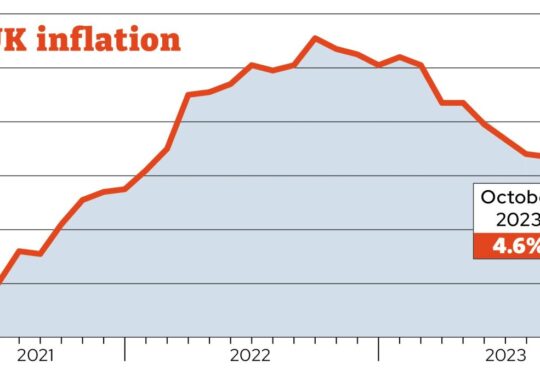
Table of Contents
Show more
Show less
Capital at risk. All investments carry a varying degree of risk and it’s important you understand the nature of these. The value of your investments can go down as well as up and you may get back less than you put in. Where we promote an affiliate partner that provides investment products, our promotion is limited to that of their listed stocks & shares investment platform. We do not promote or encourage any other products such as contract for difference, spread betting or forex. Investments in a currency other than sterling are exposed to currency exchange risk. Currency exchange rates are constantly changing which may affect the value of the investment in sterling terms. You could lose money in sterling even if the stock price rises in the currency of origin. Stocks listed on overseas exchanges may be subject to additional dealing and exchange rate charges, and may have other tax implications, and may not provide the same, or any, regulatory protection as in the UK. Tax treatment depends on one’s individual circumstances and may be subject to future change. The content of this article is provided for information purposes only and is not intended to be, nor does it constitute, any form of tax advice. Accurate at the point of publication.
Most of us know we need to be saving for retirement, but pensions can feel daunting and complex, with plenty of jargon bandied about and an array of different options.
Auto-enrolment (see section below on workplace pensions schemes) has helped millions of workers get started with their pension saving. But what about workers who are self-employed with no access to work schemes?
And whatever pension arrangements you make, the worry remains about whether your fund will grow enough for a comfortable retirement.
In reality, however, pension saving doesn’t have to be complicated. A pension works in a similar way to other savings and investment plans – just with the extra benefit of tax relief on your contributions, which boosts the overall savings pot.
Stephanie Pickering, chartered financial planner at Verity Wealth Management, says: “You may think retirement is a long way off and that other financial needs such as the mortgage or rent, bills and looking after the kids, are the only priority for now. But you can start a pension with very small savings. Doing something is better than doing nothing at all.”
What is a pension?
A pension is a long-term savings product designed to help you grow funds for retirement and old age. When you save in a pension the government gives tax relief on your contributions, which boosts your overall savings.
Pensions will have a minimum age at which you can start to receive an income or assets from the savings plan.
There are three main types of pension:
State pension: this is a benefit paid by the government to those who qualify. To get the full State pension of £203.85 a week (this is the new State pension for those reaching State pension age after April 2016) you’ll need to have 35 years of qualifying National Insurance contributions. You’ll need at least 10 years of contributions to get any State pension.
Workplace or occupational pensions: these are ‘group’ pension schemes which employees pay into through their pay or monthly salary.
In most cases the employer also makes a contribution to the plan and workers get tax relief on top. Employers must auto-enroll their staff into a pension if they are eligible – that is, over the age of 21 and earning at least £10,000 a year. Employees can opt out.
The majority of company or workplace schemes, sometimes called occupational pensions, are what’s known as defined contribution plans. This means the amount you’ll receive when you retire is dependent on how much you pay in and the investment performance of the pension fund, minus any fund charges you’ve had to pay.
Some older occupational pensions are called defined benefit schemes, also known as final salary or career-average plans. With this type of scheme, what you’re paid in retirement is dependent on your salary level when you retire and length of service with the company, not investment performance. They are considered much more valuable than defined contribution pensions, and most final salary schemes are now closed, because they offer a guaranteed income in retirement from the outset, which is harder for the provider to achieve.
Private pensions: private pensions work in the same way as defined contribution workplace pensions – what you get out is dependent on what you pay in and the investment performance of your plan. But instead of being set up by an employer, you can open one yourself.
What is a private pension?
A private pension, sometimes called a personal pension, is a long-term savings wrapper where savers or investors put money away in the hope it will grow into a sizable pot to support them in retirement.
Money in a private pension is typically invested in stocks and shares, most commonly through collective funds. The hope is that over the long term the stock market should outperform the returns on cash savings.
While private pensions do not receive employer contributions (as workplace pensions do), investors still get tax relief on their private pension contributions at their highest rate of tax. For a basic rate taxpayer this would be 20%, higher rate taxpayers get 40% and additional rate taxpayers get 45% (see section on tax relief below).
What types of private pension are available?
There are different types of private pension available, depending on how much control you want over your investment decisions and how your cash is invested, and the charges you want to pay for the fund to be managed.
Stakeholder-style personal pensions are straightforward investment plans with low minimum contributions, low charges and typically a limited range of investment fund choices. They are on offer from a wide range of investment platforms and pensions and life insurance companies.
In contrast a SIPP – self-invested personal pension – allows the investor to have full control over where their cash is invested.
A SIPP can hold a wide variety of assets, from individual stocks and shares and investment funds to commercial property and land. Investment platforms and asset management companies offer SIPPs and some have high minimum investment levels, plus the platform and trading charges are likely to be higher than with a standard personal pension.
Who should consider getting a private pension?
Anyone who wants to put aside more savings for later in life can open a private pension. They are particularly important for the self-employed and those who don’t have a pension scheme through their employer, for example.
Jon Greer, head of retirement policy at wealth manager Quilter, says: “Due to auto-enrolment most employees will automatically start saving into a workplace scheme. While there is nothing stopping someone already in a workplace scheme also saving into a private scheme they may just wish to just increase their contributions into that scheme for ease.
“However, the self-employed do not have that luxury and need to take matters into their own hands, which can be difficult given self-employed incomes can be lumpy and locking money into a pension might feel scary when you might need the money here and now.
“The self-employed should try and habitually save into a personal pension. Whether you are self-employed or a small business owner, a private or personal pension can serve as a valuable tool to build a nest egg for retirement.”
What are the benefits of a private pension?
The advantages of private pension saving include:
Tax benefits
Contributions into a private pension enjoy tax relief dependent on the pension saver’s rate of income tax. Basic rate taxpayers get 20% tax relief on contributions, higher rate taxpayers get 40% and additional rate taxpayers get 45% (rates are slightly different in Scotland).
A basic rate taxpayer who contributes £80 per month into their private pension will get tax relief on top at 20%, which would top up the total monthly saving to £100. A higher rate taxpayer only needs to pay in £60 to get the same £100 contribution – due to £40 of tax relief at 40%.
Basic rate tax relief on private pensions is added automatically. Higher and additional rate tax relief will usually need to be claimed through a self-assessment tax form each year.
Non-taxpayers who pay into a pension will usually get tax relief at 20% but the tax relief here is capped, with the maximum annual pension contribution at £2,880 with tax relief at £720 – a total pension saving of £3,600 per year
Open to all
Anyone can open a private pension (you do not have to be working or a taxpayer) and anyone can make contributions into the plan. You can open a private pension for a child, for example.
All contributions receive tax relief. For non-taxpayers this is at the basic rate of 20%. Most private pensions allow you to stop and resume contributions as and when it suits you, plus you can vary how much you pay in.
Potential for higher growth
Interest and returns earned on pension contributions are invested back into the pot so you’ll earn interest and investment returns on an even bigger pot the next year, and so on.
This is known as compounding and it can significantly boost your overall pension savings.
Limited access
You can’t usually access the money in a pension until at least the age 55 (this is rising to 57 in 2028). For most savers this is viewed as an attractive feature because it removes the temptation to withdraw funds, which is possible with other types of investment, such as individual savings accounts (ISAs), but leaves you with less for retirement.
Cash lump sum
Private pension investors can choose to take 25% of their total pension pot as a tax-free lump sum at retirement.
Flexible options at retirement
Pension savers in private pensions get a broad range of options at retirement age, including taking the whole pot as cash, receiving a regular income, keeping the money invested or continuing to save – or a combination of these options (see section on what happens at retirement below).
What are the drawbacks of private pensions?
Unlike most workplace or occupational pensions, you won’t get employer contributions into a private pension. There are also likely to be charges on a private pension, although this is true for other types of pension scheme, and other investment plans, such as stocks and shares ISAs too.
There is a cap on the tax relief you can get on all pensions. This is set at £60,000 of contributions (2023-24) or 100% of your income if you earn less than £60,000 per year, which is a downside for higher net worth individuals or those looking to maximise their pension saving.
The cap on tax relief applies across all pension contributions you make – into workplace and private pensions/SIPPs.
How do I go about starting a private pension?
- Before you look at starting a private pension, if you’re an employee check what workplace schemes are offered through your employer. You’re essentially giving up free cash if your employer contributes into a pension scheme on your behalf but you have opted out of the pension. You can open a private pension even if you already have a workplace pension. But remember the maximum tax relief and contribution limits apply across your combined pension savings.
- For private pensions consider whether you want a low-cost, straightforward savings plan where the investment decisions will be made on your behalf – or if you want a self-invested personal pension, where you can make the decisions
- Shop around and compare the investment options available and the charges applied with different pension providers
- Decide how much you can contribute to the pension each month
- For most private pensions you can open the pension online and set up a standing order for contributions
- Regularly review your pension savings to ensure you’re on track for retirement. Depending on your private pension scheme you’re likely to be able to switch investment funds and you can vary the amount you contribute.
When should I start saving in a private pension?
Starting pension saving early gives you a longer time frame to build up a more sizable pension pot. You can also hopefully ride out the peaks and troughs in stock market performance over the long term.
For younger people, pension saving has to be balanced with paying off debts, such as student loans, and saving towards a first property, if that is an ambition. But ideally pension saving should not be put off for too long. Even saving small amounts each month can add up over time.
Alistair McQueen, head of savings and retirement at private pension provider Aviva, says: “When we asks retirees what pension advice they would give to their former self, the top answer is typically ‘I wish I’d started earlier’.
“Saving a little over a longer time should set you up well for your eventual retirement. It’s never too late to start pension saving. Every penny saved today is a penny to spend later in life. And this penny saved, when invested, should grow in value while you wait.”
How much should I save in a private pension?
How much you should save into your pension depends on the lifestyle you want in retirement balanced with the money you can afford to save after your essential bills have been paid and how long you’ve got until retirement.
The Pensions and Lifetime Savings Association (PLSA’s) has independent research available on pension savings and the impact on future standard of living. It is a good place to start in learning more about your retirement goals and what it will cost.
Armed with greater information about how much you’ll need in older age, you can use an online pension saving calculator to work out how that translates to monthly savings based on your age.
Dean Butler, at pension provider Standard Life, says: “It’s worth noting that reliance on the state pension alone wouldn’t even meet the PLSA’s minimum living standard, and that most people will need to contribute more than the auto-enrolment minimum – 8% of salary – to reach the higher living standards.
“To secure the PLSA’s ‘moderate’ lifestyle in retirement – £23,300 a year for a single person, you’d currently need around £330,000 in your pot to have enough to buy an annuity to achieve that level of income. The most important thing is to regularly review your pension pot against your retirement plans, and fill in gaps when you can.”
What are the maximum savings limits in private pensions?
You can save as much as you want into pensions, but there are limits on the amount of tax relief you can get on your contributions each year. Pension pots are also hit with higher tax once they exceed a certain value.
As outlined earlier, the maximum level of total pension contributions that qualifies for tax relief is £60,000 per tax year (2023-24) or 100% of your income if you earn less than £60,000 a year.
There is no longer a maximum limit on the amount you can save into a pension (this was known as the lifetime limit). But once a pension pot reaches a total value of £1,073,100, higher tax rates apply when you come to withdraw your money at retirement.
For pensions above this maximum limit and taken after April this year (2023), savers will pay income tax on some or all of the lump sum from their pension.
Ms Pickering at Verity Wealth Management says: “Take independent advice before you do anything that might affect your contributions and annual allowance. It usually makes sense to get your accountant to work with your financial advisor to find the best outcome for your situation.”
When can I access my private pension?
Since April 2015 savers in private pensions have been able to access their retirement funds, if they wish, from age 55. This minimum age will rise to 57 by 2028. But remember the earlier you access your pension savings the smaller the lump sum and income you’ll get. Leaving your investments to grow for longer is likely to lead to more money in retirement.
Can I access my pension funds early?
You can only usually access your pension savings early (before 55) in very specific situations, such as diagnosis of a terminal or serious illness.
The whole purpose of a pension is that the money should not be touched and it is set aside for your retirement.
What happens with my private pension at retirement?
Savers and investors with private or personal pensions will typically have a range of options with their pension once they reach retirement.
First, you don’t have to withdraw cash or start taking an income immediately when you reach the age your pension provider has recorded for you to retire. You can leave your money invested in the pot to access later. This could mean you end up with a better income at a later date.
Alternatively you can choose to take 25% of the total pot as a tax-free lump sum and then use the rest to buy an annuity.
An annuity is a financial product that basically secures you a fixed income for the rest of your life, no matter how long you live. There are different types of annuities, such as for couples, or where the payments you receive are index linked. Annuity income is taxable.
Another option is drawdown. This is where you access the money saved in your fund at different times to suit your needs, keeping the rest invested in the plan. You can take your 25% cash lump sum and leave the rest invested, for example.
You can also take the whole pension as cash – either immediately or in stages. But only the first 25% is tax-free. The rest of the pension will be taxed as income.
Alternatives to private pensions
Many people choose to save in ISAs instead of private pensions. There are pros and cons to this route compared to pension saving.
Pensions will generally provide better tax relief. But ISAs offer greater flexibility in that savers can access their money at any time. Both SIPPs and stocks and shares ISAs can give investors greater control over their investment decisions, compared to stakeholder private pensions. Annual management and platform charges will usually apply for pensions and investment ISAs.
Ideally, savers might have a combination of different financial products, including pensions, ISAs and other cash savings plus investments, to spread out the risk. Also different products may suit different savings needs and goals at different times. You can save and invest far more in a pension, receiving tax relief on top, compared to the much smaller annual ISA limits.
Some alternatives to pensions include:
- Lifetime ISA: a tax-free savings plan designed to help those aged over 18 but under 40 save a deposit towards a first home, or save for retirement. The annual savings limit is £4,000, and this counts toward your £20,000 a year ISA allowance. The government pays a 25% bonus on savings – up to a maximum bonus of £1,000 per year, until the ISA holder is 50. Those using a LISA for retirement planning can access the money from age 60
- Investment ISAs: tax-efficient investment wrappers. Investors can put up to £20,000 a year into an ISA and the funds are invested in stocks and shares and investment funds, such as unit and investment trusts. Savers can choose to self-select their own investments through an online platform or opt for a ‘ready made’ stocks and shares ISA plan from an investment provider.






